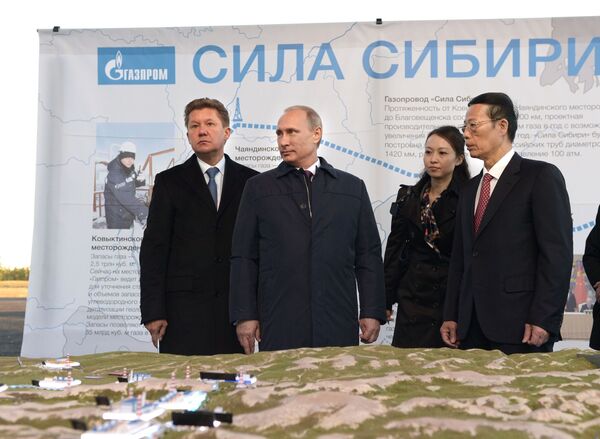The Russian-Chinese natural gas pipeline Power of Siberia will launch on 2 December during a joint teleconference between Russian President Vladimir Putin and his Chinese counterpart Xi Jinping, the Russian head of state’s press secretary confirmed this week.
The energy megaproject between Russia, the world’s largest gas exporter, and China, the world's largest gas consumer, is not only expected to deliver 38 billion cubic metres of Russian gas to the Asian industrial giant in the next 30 years, but is also expected to strengthen the economic and political cooperation between Moscow and Beijing.
“This is a strategic project of Russian-Chinese cooperation in the energy sector. It is extremely important for deepening comprehensive cooperation”, Chinese Foreign Ministry spokesman Geng Shuang said in the beginning of November.

Visit of Vladimir Putin to the Far Eastern Federal District, 1 September 2014
© Sputnik / Алексей Никольский
/ Here is a list of facts to know about Power of Siberia prior to its historic launch on 2 December.
- In 2014, Vladimir Putin called Power of Siberia “the largest construction project in the world”, noting that it was tremendously important both for Russia and China.
- The gas fields at the centre of the Power of Siberia project, Chayandinsky in Yakutia and Kovyaktinsky in Irkutsk region, were discovered in eastern Siberia in the 1980s. However, their development was not started right away due to their remoteness from the USSR’s major gas pipelines.
- The name “Power of Siberia” (“Sila Sibiri”) was coined by Russian the gas giant Gazprom in a public competition, with Vladimir Putin announcing it in December 2012.
- Initially, Power of Siberia project referred to the Chayandinsky gas field and entailed the construction of a pipeline system that would run from Yakutia to Khabarovsk and Vladivostok. The negotiations to connect the pipeline to China began in 2012, with the name subsequently evolving to incorporate the whole project. Gazprom later made a decision to connect the Chayandinsky gas field with the Kovyaktinsky one, with the latter expected to become operational in 2022.
- The 30-year contract between Russia’s Gazprom and the China National Petroleum Corporation (CNPS) on the creation of a major new pipeline system to supply Russian gas to north-eastern China was signed in May 2014, with the total estimated value of the project being $400 billion.
- In 2017, Gazprom and the CNPC also began the construction of a crossing under the Amur River within the trans-border section of the Power of Siberia pipeline, which was completed this year.
- The natural resources in the Chayandinsky and Kovyaktinsky fields would allow for the extraction of 50-60 billion cubic metres of Russian gas per year, according to Deputy Director General of Russia’s Energy Security Fund Alexey Grivach. Russia plans to gradually increase the gas deliveries annually, raising the amount of gas from five billion cubic metres to 15 billion over the period of 2020-2022.
- The gas pipeline will run through extreme climatic conditions, including an expected minimum of -62°С in the Yakutia region, which is believed to be one of the coldest places on Earth. All the pipes used in the construction of Power of Siberia, which are produced in Russia, are set to address the extreme weather conditions with the help of innovative nanocomposite materials in order to provide high resistance to corrosion.
- In addition to exports to China, Power of Siberia will provide resources to the upcoming Amur Gas processing plant that will soon feature the world’s largest helium production enterprise.
- Gazprom and China are also currently negotiating the supply of gas through a western route, given the name Power of Siberia-2, potentially running from western Siberia to Novosibirsk and the Russian-Chinese border. Another joint project would include the supply of gas via the Far Eastern route from the Sakhalin field.



